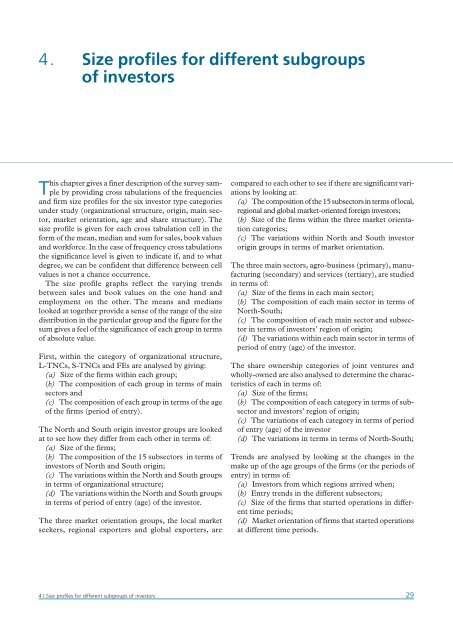Africa Foreign Investor Survey 2005 - unido
Africa Foreign Investor Survey 2005 - unido
Africa Foreign Investor Survey 2005 - unido
Create successful ePaper yourself
Turn your PDF publications into a flip-book with our unique Google optimized e-Paper software.
4. Size profiles for different subgroups<br />
of investors<br />
This chapter gives a finer description of the survey sample<br />
by providing cross tabulations of the frequencies<br />
and firm size profiles for the six investor type categories<br />
under study (organizational structure, origin, main sector,<br />
market orientation, age and share structure). The<br />
size profile is given for each cross tabulation cell in the<br />
form of the mean, median and sum for sales, book values<br />
and workforce. In the case of frequency cross tabulations<br />
the significance level is given to indicate if, and to what<br />
degree, we can be confident that difference between cell<br />
values is not a chance occurrence.<br />
The size profile graphs reflect the varying trends<br />
between sales and book values on the one hand and<br />
employment on the other. The means and medians<br />
looked at together provide a sense of the range of the size<br />
distribution in the particular group and the figure for the<br />
sum gives a feel of the significance of each group in terms<br />
of absolute value.<br />
First, within the category of organizational structure,<br />
L-TNCs, S-TNCs and FEs are analysed by giving:<br />
(a) Size of the firms within each group;<br />
(b) The composition of each group in terms of main<br />
sectors and<br />
(c) The composition of each group in terms of the age<br />
of the firms (period of entry).<br />
The North and South origin investor groups are looked<br />
at to see how they differ from each other in terms of:<br />
(a) Size of the firms;<br />
(b) The composition of the 15 subsectors in terms of<br />
investors of North and South origin;<br />
(c) The variations within the North and South groups<br />
in terms of organizational structure;<br />
(d) The variations within the North and South groups<br />
in terms of period of entry (age) of the investor.<br />
The three market orientation groups, the local market<br />
seekers, regional exporters and global exporters, are<br />
compared to each other to see if there are significant variations<br />
by looking at:<br />
(a) The composition of the 15 subsectors in terms of local,<br />
regional and global market-oriented foreign investors;<br />
(b) Size of the firms within the three market orientation<br />
categories;<br />
(c) The variations within North and South investor<br />
origin groups in terms of market orientation.<br />
The three main sectors, agro-business (primary), manufacturing<br />
(secondary) and services (tertiary), are studied<br />
in terms of:<br />
(a) Size of the firms in each main sector;<br />
(b) The composition of each main sector in terms of<br />
North-South;<br />
(c) The composition of each main sector and subsector<br />
in terms of investors’ region of origin;<br />
(d) The variations within each main sector in terms of<br />
period of entry (age) of the investor.<br />
The share ownership categories of joint ventures and<br />
wholly-owned are also analysed to determine the characteristics<br />
of each in terms of:<br />
(a) Size of the firms;<br />
(b) The composition of each category in terms of subsector<br />
and investors’ region of origin;<br />
(c) The variations of each category in terms of period<br />
of entry (age) of the investor<br />
(d) The variations in terms in terms of North-South;<br />
Trends are analysed by looking at the changes in the<br />
make up of the age groups of the firms (or the periods of<br />
entry) in terms of:<br />
(a) <strong>Investor</strong>s from which regions arrived when;<br />
(b) Entry trends in the different subsectors;<br />
(c) Size of the firms that started operations in different<br />
time periods;<br />
(d) Market orientation of firms that started operations<br />
at different time periods.<br />
4 | Size profiles for different subgroups of investors<br />
29
















